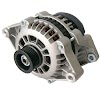Primary and Secondary Distribution
Depending upon the rating of Distribution voltage the distribution systems are mainly classified in to types,
1. Primary distribution (High voltage distribution).
2. Secondary distribution (Low voltage distribution).
1. Primary Distribution system: The electrical power is generated at power stations. The generation voltage is usually 11kv and in some cases it may be 3.3kv, 6.6kv (or) even 33kv. This voltage is step-up from 11kv to 400kv (or) even 765 kv at the generations depending upon the length of the transmission line and the amount of power to be transmitted.
The primary transmission lines transmit the power from the generating stations to various primary substations through EHV lines. At these primary substations the voltage is stepped down to 33kv (or) 66kv by means of step-down transformer.
From the primary substations electrical power is transmitted through secondary transmission lines at 33kv to various secondary transmission substations. At these secondary substations the voltage is further stepped-down to 11kv (or) 6.6 (or) 3.3 kv using step-down transformer.
At this rated voltage (11kv (or) 6.6kv (or) 3.3kv ) the power is conveyed for distribution and also to the bulk supply consumers. Such a system is know as “Primary distribution system”.
Primary distribution system is defined as a place from which the power is distributed between secondary transmission substations to the primary distribution substation (or) bulk power supply consumers.
2. Secondary distribution system: at distribution substations the voltage is stepped down to 400volts, (line-to-line) and 230 volts (phas-to-neutral) using delta-star transformer.
Secondary distribution system: is defined as a place from which the power is distributed between primary distribution system to domestic, commercial and small industrial consumers.
Definitions
The distributions comprises of feeders, service mains and distributors.
Feeders: Feeders are the conductors which connects substations [in some cases generating stations] to the area served by these stations.
No tappings are taken from the feeders to feed to the consumers hence the current flowing through the feeder remains constant. Therefore, feeders are mainly designed on the basis of its current carrying capacity.
Distributors: Distributors are the conductors from which numerous tappings are employed for supply the power to the consumers.
The current flowing through the distributor lines are not constant along its length. Hence the distributor lines are mainly designed on the basis voltage drop.
Service mains: service mains are the conductors, which connects the consumers terminals to the distributors.












0 Comments